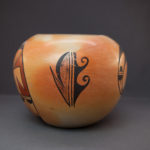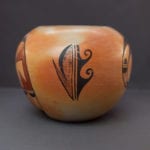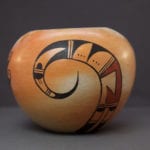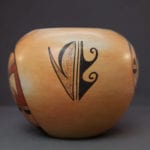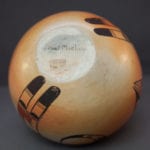The globular shape of this pot is pleasing to the eye, though the vessel is thick and therefore heavy. The blushing from the outdoor firing is exceptionally warm and prominent given the large unpainted areas on the jar.
The design consists of two elements each repeated twice on opposite sides of the vessel. The smaller design is bifurcated, with the right side consisting of two black curls (perhaps representing running water) and the left side a speckled form consisting of a rounded hill with a jutting point. Embedded in this “hill” is a black arc that visually ties this side of the design to the other. Between the two halves is a single black line.
The larger design, which visually dominates the pot, is a classic Sikyatki bird formed of six segments, the segment before the tail is painted with clay which fires red and provides the only color in the design. Each segment contains standard design elements rendered with a high degree of control. The first pot in this collection (1960-01 by Anita Polacca) features a Sikyatki bird very much like the design on this pot. Anita’s version has only five segments and is almost fully curled into a circle (to fit the space on the bottom of its bowl). On pot 2013-25, the bird is not so fully curled and sort of bows humbly at the waist, its tail just past vertical, its eyes almost parallel with the base, its beak pointing almost straight up to the mouth of the vase.
I use the word “humble” to describe position of the design because I am moved by the determined, humble life of its maker. We know about Ethel and her family because of an unusual correspondence between her and an Anglo woman from Massachusetts, Maud Melville. Their friendship is documented in Hopi Summer: Letters from Ethel to Maud, by Carolyn Davis (2007) Ethel Muchvo was probably born in the 1880s and died on February 22, 1970. Born Ethel Salyah of the Parrot/Katchina Clan, Ethel was sister to Hattie Carl, who was also a potter (2008-03). Ethel married Wilfred Muchvo and they seemed to have had a long and supportive relationship through very difficult times. Wilfred developed tuberculosis and was nursed by Ethel for many years before he died in June of 1942. Together, they had several miscarriages and twelve live born children. Of these, only the last, Vivian Muchvo (born in August of 1931), lived to become an adult and, in fact, became a grandmother.
During the Depression, the family was on the verge of starvation in part because of drought that stunted the corn, in part because there was no market for Indian crafts and in part because Wilfred was often too sick to work. “Ethel was a remarkable and strong woman who remained optimistic and practical, doing all that she could to provide for her family” (Davis, 2007:146). The loss of so many loved children was a core sadness in Ethel’s life and the survival of her youngest her greatest joy. For some additional details of this family story, see 2012-09.
It is difficult to know someone from secondary sources, but Ethel seemed to embody the virtues of a life lived according to Hopi values and it is an honor for this collection to contain a pot by her.
By the time daughter Vivian was five years old (1936), her mother was teaching her to make pottery (Davis, 2007:139). A year later Ethel was substantially blind and could no longer make her own pottery (Davis, 2007:145). Three weeks before I purchased pot 2013-25, another pot signed “Ethel Muchvo” was listed and sold on eBay. (I was the under bidder; copy of the listing on file.) These two pots are the only examples of Ethel’s work that I have seen. The design on the pot that sold earlier is precisely drawn, but the large letters of the signature are scrawled across the bottom and continue up the side of the vessel. I conclude that Vivian painted that pot but that her largely blind mother signed it.
In contrast, the signature on pot 2013-25 is small and precise and matches the handwriting on pot 2012-09 by Vivian in this collection. Thus, I believe that pot 2013-25 was formed by Ethel and painted and signed by her daughter, a very sweet scenario given the mother’s great joy in her surviving child. If Vivian was at least 14 when she painted for her mom, pot 2013-25 would date to the last 25 years of Ethel’s life, 1945 to 1970, but this is just a guess.



